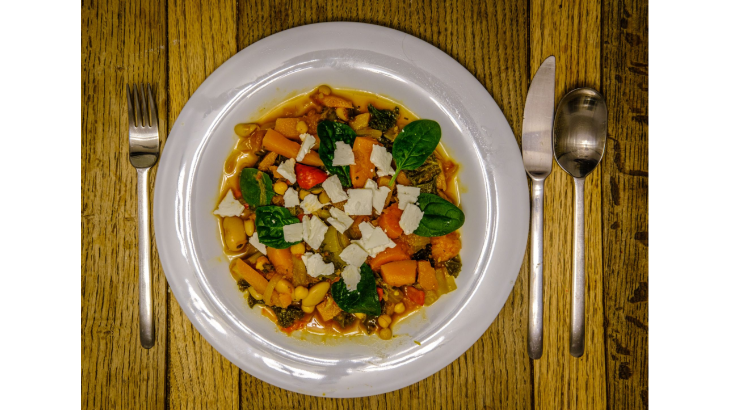Bean and Vegetable Hotpot

This is one of my favourite recipes, not least because you can use up any vegetables that are waiting in the fridge for inspiration to strike!
The version in the picture contains onions, garlic, a couple of sticks of celery, a tiny piece of root ginger, finely chopped, butternut squash, sweet potato, carrots, swede, red peppers, three sorts of beans, a tin of tomatoes, curly kale and a slosh of red wine. The finished dish was topped with a few leaves of raw baby spinach and some crumbled feta cheese. We eat it with fresh bread to mop up the juice, and as some versions have more of a soupy finish, it makes a hearty chunky soup to eat from a bowl on a cold day.
We like a slightly spicy, smoky flavour, so I use flaked chilli and smoked paprika, but you can vary this, and substitute or add cinnamon, coriander seeds, fenugreek – whatever is lurking on the spice rack.
The hotpot has the beauty of being a vegan meal - excluding, of course, the feta, it has no gluten and you can include or leave out anything you don’t like (one of our family members can always detect celery, no matter how small it’s diced!).
Assemble the veg, and prepare it by dicing the onions, chopping the garlic and root ginger, and chunking the celery. Use a good splash of oil and sauté these lightly, taking care not to singe them which imparts a slightly bitter flavour to the finished dish. Add the spices at this stage, to release the flavour.
While the sautéing is happening, dice or chunk the root vegetables and squash, and add first the biggest chunks, or the vegetables that take longest to cook, to the pan. I like to vary how the vegetables are prepared, so the swede was cut into sticks, the butternut squash into cubes and the sweet potato into larger chunks. Next add the peppers, the tin of tomatoes, red or white wine and a small bay leaf. Rinse out the tomato tin with water and then crumble a stock cube into the mix. Stir frequently to make sure everything is well-mixed and incorporates all the flavours, but don’t be over-vigorous as this can break up the vegetables and cause some to become mushy. Next add the beans, and again, stir carefully but thoroughly. Now leave the pot to simmer slowly, testing the vegetables with the tip of a sharp knife so you know when everything is cooked. Make sure the pot doesn’t dry out, topping up with water if necessary. At this point add herbs – I used dried herbes de Provence, but again, go with your preference and what you have available.
The pulses I used were butter beans, cannellini, and chickpeas, all bought dried, soaked overnight and cooked the previous day, retaining the cooking fluid, which went in the pot too. If you prefer to use canned beans, the juice in the tin is fine to use. Once all the root vegetables are cooked and the beans well incorporated, add the shredded kale. This goes in last so it doesn’t overcook, which would spoil the look and destroy the vitamins.
To serve, add a few leaves of spinach to the top as well as crumbled feta cheese. If no spinach, garnish with fresh parsley, or very finely shredded raw kale – that splash of green brings out the colours of the cooked vegetables, because “we eat with our eyes!” and what looks good tastes better.
